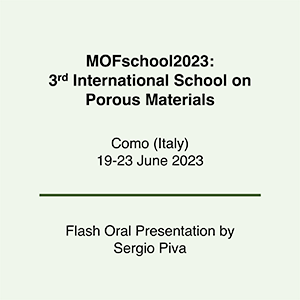Como (Italy), 19-23 June 2022, Flash Oral Presentation by Sergio Piva
Title: “Porous Hafnium-Based Metal-Organic Framework (MOF) Nanocrystals for Efficient Radioactive Gas Detection”
Authors: S. Piva, J. Perego, C. X. Bezuidenhout, S. Bracco, A. Monguzzi and A. Comotti
Abstract
Detecting radioactive gases is becoming essential in modern society to monitor nuclear activity and reduce the exposure risk to those gases being potentially harmful to persons and the environment. Liquid scintillators, i.e., materials that produce light pulses upon interaction with ionizing radiation, are currently used as radiation detectors despite the low sensitivity, complex sampling and preparation procedure. A potential breakthrough solution to overcome these problems is using solid porous scintillators that concentrate the gas and increase the detection sensitivity. Metal-organic frameworks (MOFs) stand out as materials of choice for this application being highly porous and having rigid and directional connectivity that allows the inclusion of highly luminescent conjugated chromophores. The excellent scintillating properties of MOFs have already been demonstrated by previous works, where the fluorescent MOFs were embedded in a polymer generating a composite material. [1,2] Here we demonstrate the capability of a novel porous hafnium-based MOF exploiting dicarboxy-9,10-diphenylanthracene (DPA) as a scintillating conjugated ligand to detect gaseous radionuclides.[3] The nanocrystals (Fig. 1A) show fast scintillation properties in the nanosecond time range and a fluorescent quantum yield of about 40%. The presence of a heavy element such as hafnium (Hf) also enables a good light intensity output under ionizing radiation. The MOF’s highly accessible porosity allows it to host noble gas atoms (Fig. 1B) that can diffuse inside the cavities, as proved by argon (Ar) and krypton (Kr) adsorption isotherms at 77 K (Fig. 1C). Direct detection of noble gas diffusion into the pores have been observed by hyperpolarized (HP) 129Xe NMR experiments (Fig. 1D), demonstrating the highly selective uptake of Xe in extremely diluted conditions (2% Xe in N2 and He gas mixture) under flow conditions. Finally, adsorption and detection of radionuclides have been explored using a newly developed device based on the time-coincidence technique, demonstrating an improved sensitivity compared to reference detector, thus enabling the possibility to use these MOF nanocrystals in a new generation of gas detectors. [1] J. Perego et al., Nature Photonics (2021), 15, 393-400 [2] J. Perego et al., Nature Communications (2022), 13, 3504 [3] M. Orfano, J. Perego, F. Cova, C. X. Bezuidenhout, S. Piva, et al., Nature Photonics 2023.

